Nile River cruise a taste of modern luxury amid ancient history
Sail Egypt’s fabled river on a boat fit for a pharaoh.
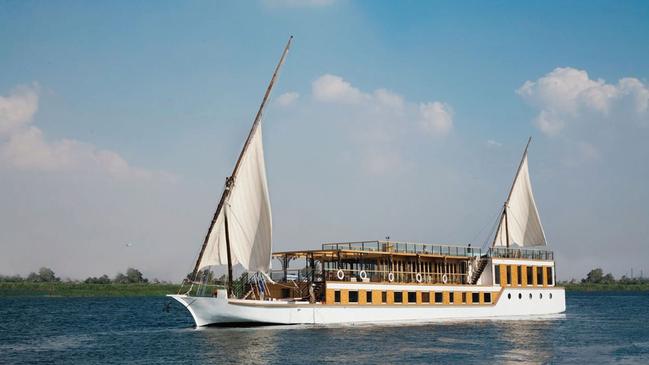
The temptation to get into Agatha Christie mode, choose who is to play the corpse and assign the role of murderer, is nigh irresistible. We are a convivial group of six about to cruise the Nile in style. The seventh member of our party is Hesham Abdulla, an Egyptologist of great erudition and twinkle-eyed charm. He understands our humour and is enormously forgiving of bad jokes about “going the extra Nile” and our frankly terrible Poirot impressions.
All of this camaraderie is important as our boat is a charter. There are no other passengers, just local crew, and so we are a true house-party afloat, cruising 210km from Aswan north to Luxor over four days and, as it transpires, having more fun than seems quite proper. And sorry, Hercule, no daggers are sighted; we all survive unscarred.
The key heritage sites of Upper Egypt unfold like a concertina as we venture ashore each day in the sepia light of early morning and the lengthening grey shadows of late afternoon. It is baking hot this May with temperatures effortlessly hitting 45C by noon. We wrap up in cotton scarfs against the heat and dust and admire the easy, swinging gait of tour guides in their flowing gallibaya robes. Hesham opts for an Indiana Jones-style hat but barely raises a sweat.
The landscapes have a spare, savage beauty even when viewed through gauzy light from our river boat, Sanctuary Zein Nile Chateau, a reimagined twin-sail dahibaya. About 60m in length, it was built in 2010 and carries up to 12 passengers. We can’t help but imagine we are aboard a royal barge of the gilded Pharaonic era.
The comfortable decor is not over-opulent but tends more to brass-latticed lanterns, giant vases of lilies and amply cushioned furniture. But then there is the Farouk Suite, at the stern of the upper deck, which is where I am ensconced, and its grandeur amuses my companions no end. Is it uncivilised that, rather than kingly connections, I am rather more thrilled to hear that a past occupant was Leonardo DiCaprio?
Full-length windows curve around this parquet-floored, ballroom-like extravaganza of 93sq m, furnished with a sleigh bed, empire furniture, pedestals, handwoven rugs, and palace memorabilia, including a gallery of black and white images of King Farouk, ruler of Egypt from 1936-1952. His cartoonish waxed moustache is said to have been the inspiration for actor David Suchet’s TV interpretation of Poirot.
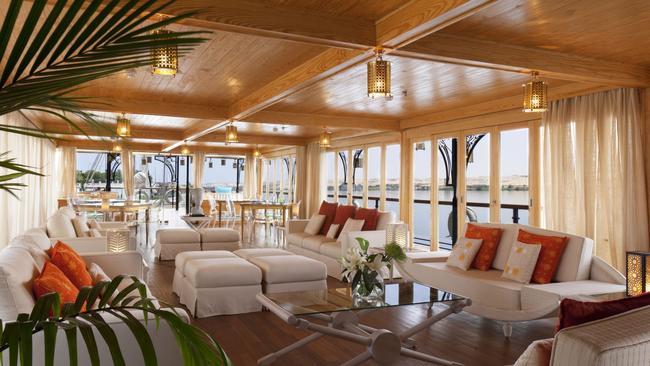
Also in evidence among the photography is Farida, his first wife, with whom I share a similar hairstyle and swarthiness, if not a wardrobe of tiaras and furs. And so almost instantly I become known as Queen Farida among our group, which is amusing, but shaking the name is impossible. Even Hesham is cheekily calling me Farida by the time we venture ashore from our adjacent moorings to the Ptolemaic temple at Kom Ombo, and that’s only our first afternoon.
On the main (actually lower) deck, the Napoleon Suite is furnished with a contemporary four-poster and its chart-like wallpaper tracks the French emperor Bonaparte’s military route through Egypt and the Levant in the late 18th century. Also on this level are three double and one twin cabin, each 20sq m, which are much cosier but light and bright with good ensuites. On the sun deck, up top, is a smallish, mosaic-tiled pool, a phalanx of lounger beds, and views in all directions.
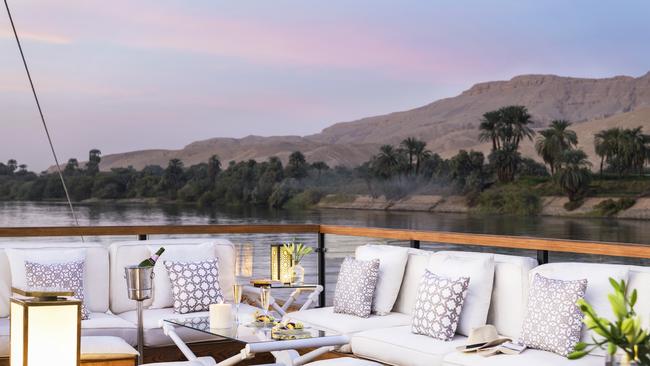
We all come to love chef Hosny’s varied and uniformly delicious buffets. There are complicated vegetable stews rich with okra and spinach; fried Nile perch, a fish once revered as sacred; flat breads and savoury dips; honeyed desserts sprinkled with sesame seeds; and creamy pastries. Broad-smiling waiters Ali and Abrahim pose graciously for our cameras and appear with espressos and chilled handtowels before we even know we’re in need of such things. Manager Khaled, the most gracious of hosts, is unflappable in a handsomely tailored suit.
The second morning, just after dawn, I’m woken by spooky rat-a-tat-tat noises and presume someone is knocking at the door. We have been moored overnight, beside banana groves and fields of sugarcane, after visiting the exquisitely preserved Temple of Horus at Edfu. I call out and no one answers but the taps continue. I soon realise birds are banging on the Farouk Suite’s bowed windows, worrying at their own reflections.
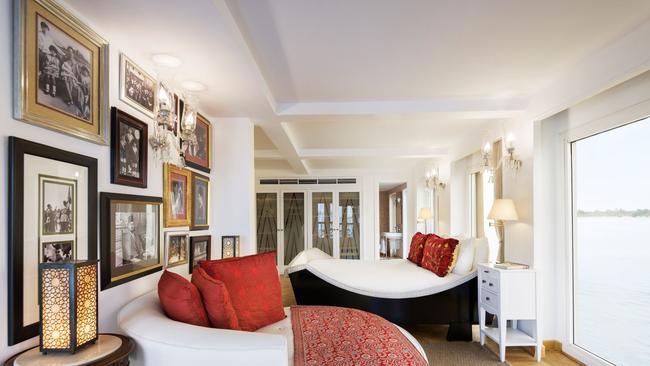
When I draw back the curtains, they fly about in panic, black wings whirring and smashing. But it’s good to be up early so I creep to the sun deck and watch the day unfurl. Small, sharp-beaked birds, which I think could be bee-eaters, flit about on a lively breeze like scraps of emerald satin. White spires of minarets peep through bunched greenery and dusty pink oleander. But the lush riverine strip is all window dressing, as it were, as about 10km inland start the sandy “vastlands”, as Hesham calls the unforgiving deserts.
On another morning, as day breaks, hot-air balloons hang like teardrops over the Nile, moving slowly with the thermals.
Egypt has long been radiant in my imagination — the cultural riches, that unknowable engineering, the fables, the sequence of invasions. We visit temples and monuments familiar from pictures that decorated my high-school classrooms. I tell Hesham I feel giddy. He doesn’t even ask if it’s the heat. He knows it’s the history, the overpowering sense of being amid remnants of the civilisation that gave us mathematics, geometry, metallurgy, astronomy, accounting, writing, paper, medicine, the ramp, the lever, the plough … I murmur all this aloud from a guidebook but I don’t doubt its veracity.
Our river boat passage is slow and steady, seamlessly connecting the elements of our itinerary. We tie up at tight moorings where bigger Nile cruisers wouldn’t fit and redesign the itinerary to allow for a leg-stretching village visit. We amble past fields of alfalfa, waving to farmers riding donkeys bareback or driving oxen-pulled carts. They look as if they are emerging in puffs of dust from the pages of the old Testament. In a busy marketplace, traders at an open-air souk are dealing in spices, bunches of spinach and clearly doomed animals.
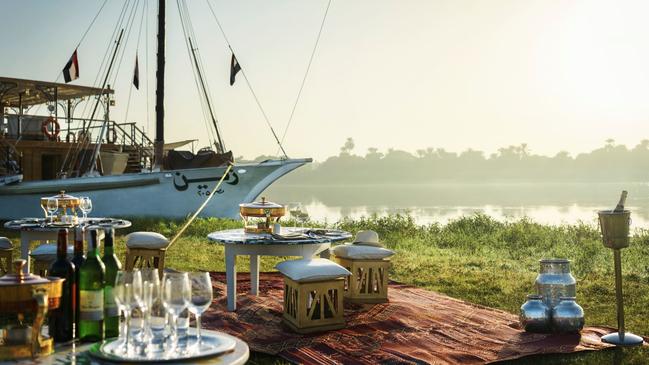
Sitting cross-legged in a circle on striped rugs under a makeshift canopy, about a dozen men lounge about. I ask Hesham what they’re up to. “Smoking and talking … the usual,” he smiles. For our return to the river, we commandeer two local lads to take us in a tractor-like cart with side seating. We slip and slide and bop along to a ghetto blaster playing groovy Arabic music as chickens and goats scatter at our approach. It is madly, joyously uncomfortable. When we arrive at the riverbank, I ask one of the “drivers” his age. He holds up eight fingers. Gasp.
Shore excursion highlight? On the west bank of the Nile, about 55km south of Luxor, the town of Esna is the site of a temple dedicated to Khnum, the much-revered, ram-headed god of creation. It was reconstructed in the Greco-Roman era (332BC-AD642) from an earlier edifice. The site is virtually deserted during our shore excursion, but it’s the casual way in which we almost stumble upon it that is so remarkable. The red sandstone temple is recessed about 9m in an excavated pit between the settlement’s flat-roofed, utilitarian mud-brick buildings. Washing is flapping from balconies all around, kids are kicking soccer balls.
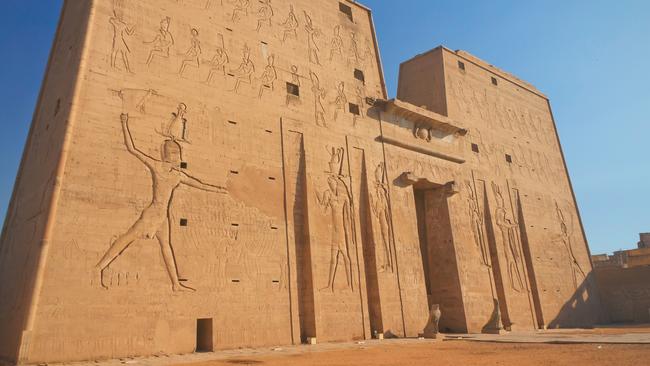
It seems incongruous until Hesham explains that successive layers of sand, silt, development and debris over at least 1500 years have helped to preserve the temple. During the reign of Mohamed Ali (1805-1849), when many important buildings were demolished to retrieve stone for construction, the hypostyle hall of the Temple of Esna was used for cotton storage, saving it from destruction. Today, scaffolding stretches up 18 parallel columns and six half columns to lotus and palm-leaf capitals and a ceiling carved with constellations and zodiac symbols.
In a government initiative, workers are painstakingly cleaning and restoring weathered grime to reveal the original mineral colours, such as azurite and malachite. Pigeons swoop low above our heads.
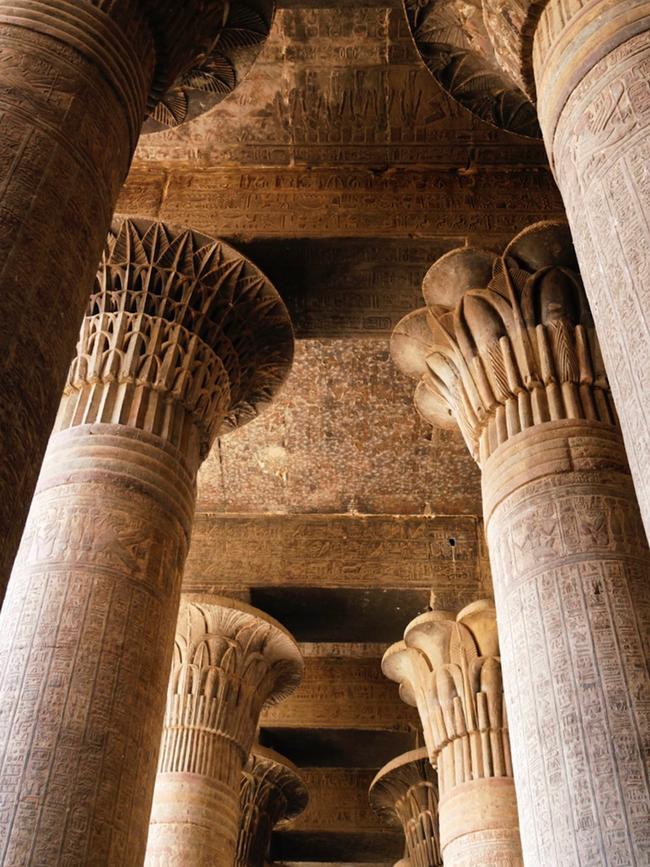
Stylised reliefs show Khnum with his consort, Menhit, and Greek and Roman emperors dressed as pharaohs. “What we see is only about a quarter of the original building,” says Hesham. “As ever in Egypt, so much more lies beneath.”
As always throughout this adventure, Hesham’s commentary is delightfully elliptical, full of anecdotes, whiffs of scandal and intrigue. The learning is gentle and enjoyable. By the end of our journey we can decode many a hieroglyph. I learn to identify depictions of the gods Ra and Horus, know Hathor from Hatshepsut, Nefertari from Nefertiti. But all the details I don’t even begin to understand still fill me with absolute wonder. I would (almost) kill to return.
Susan Kurosawa was a guest of Abercrombie & Kent
-
In the know
Charters aboard Sanctuary Zein Nile Chateau operate in both directions between Aswan and Luxor. Itineraries can be tweaked to suit guests but typically cover the major sites, including the treasury of tombs in the Valley of the Kings and the Temple of Karnak in Luxor.
Sanctuary Retreats also runs larger riverboats on the Nile, with luxurious appointments and similar shore excursions. The retro-styled Sanctuary Sun Boat III has 18 cabins; Sanctuary Nile Adventurer has 32 cabins; Sanctuary Sun Boat IV features 36 cabins and four suites.
Abercrombie & Kent offers cruise packages with land content, including Cairo, Alexandria, Aswan and Luxor. Check DFAT travel advisories before planning a visit.
■ abercrombiekent.com.au
■ sanctuaryretreats.com
■ smartraveller.gov.au
-
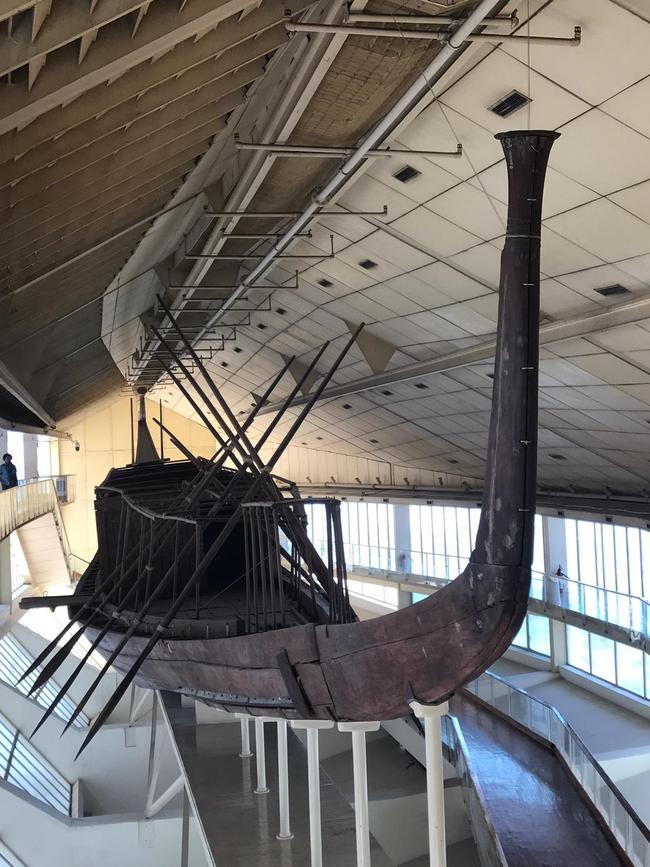
More to the story
Egyptian-French expert guide Hesham Abdulla has been working for Abercrombie & Kent for 24 years and lists the following seven as his recommended not-to-be-missed sites in Egypt.
■ Egyptian Museum of Antiquities and its Mummy Room, Cairo
■ The Pyramids of Giza near Cairo
■ Solar Boat Museum, to the side of the Pyramids (pictured)
■ The Step Pyramid at Saqqara, about 20km east of Giza
■ Tombs and burial sites in the Valley of the Kings, Luxor
■ The massive rock temples of Abu Simbel, overlooking the Aswan High Dam near the border with Sudan
■ Temple of Karnak at Luxor

To join the conversation, please log in. Don't have an account? Register
Join the conversation, you are commenting as Logout